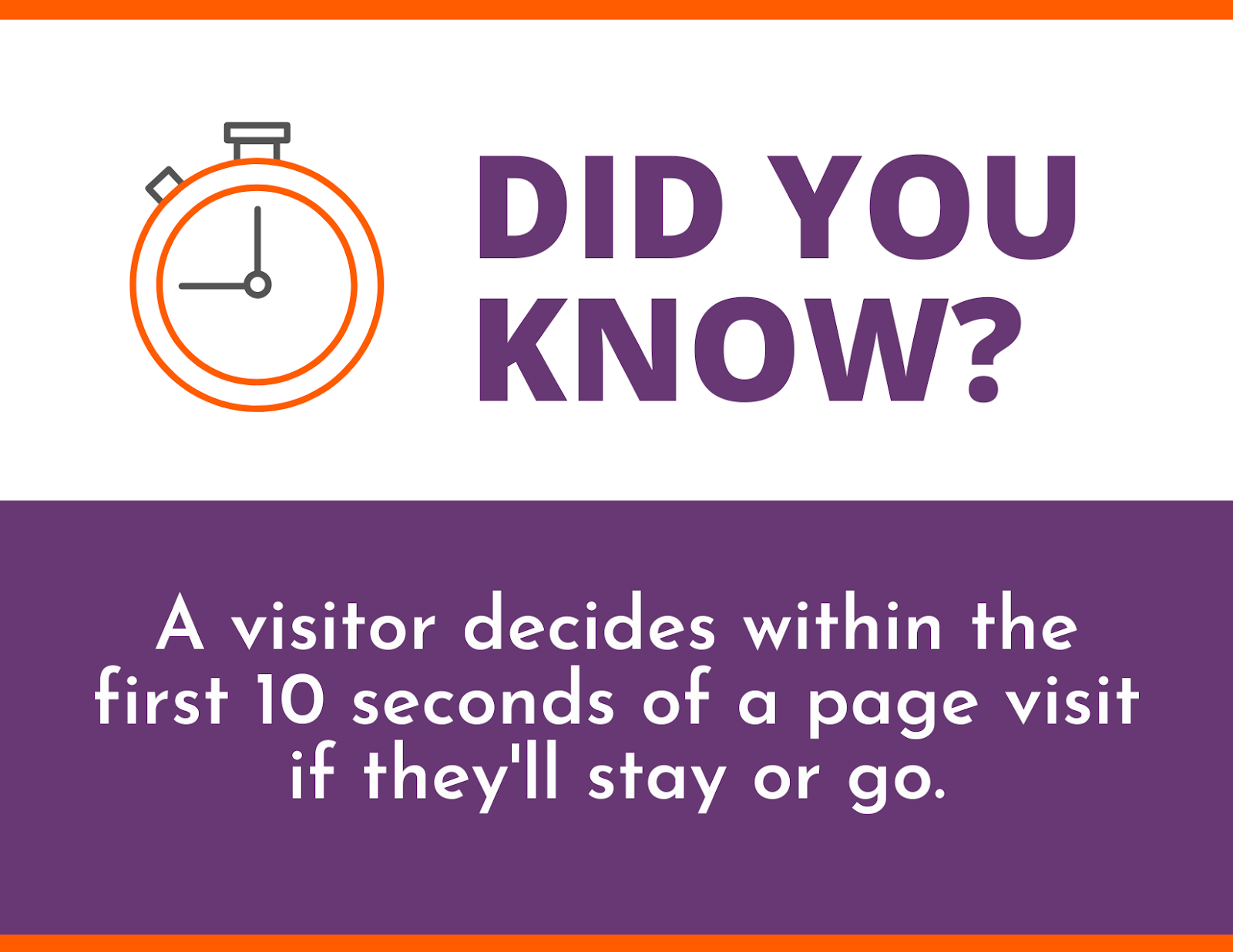You Don’t Need More Website Visitors, Just Better Ones
Have you ever invested in a pay-per-click campaign that sent a surge of traffic to your website but once the budget ran out, you saw a significant drop in visitors?
You’re not alone.
We hear from clients all the time about the moment they turn off an ad, they realize they aren’t receiving the same traffic they once saw through paid search.
While pay-per-click advertising like Google or Facebook Ads is a great tactic to draw in new visitors, it is not a sustainable strategy for your website in the long term.
Even SEO tools that capitalize on popular keywords and search queries can only take your traffic so far.
The common denominator most businesses miss in this equation is that their website was likely not designed with lead generation and growth in mind.
Why Isn’t Pay-Per-Click Advertising Enough?
Beware the agency who encourages you to invest solely in pay-per-click advertising to bring visitors to your website.
We’ve seen firsthand disgruntled business owners who feel cheated or burned by an agency because of a lack of education from the advertisers responsible for supporting their PPC (pay-per-click) campaigns.
Pay-Per-Click Advertising Is Only One Piece of The Puzzle
Although pay-per-click ads can play a part in attributing to higher website traffic and visitors, your website’s design and content is what will engage your visitors in the long run.
If your marketing budget is limited, you need to know what other options are available to maximize your ROI and your agency partner should be able to educate and inform you on what will make the most impact for your bottom line.
And if PPC isn’t enough, how can you keep website visitors from dropping off when they finally get to the right page?
Where Do Website Visitors Tend to Drop Off?
When you see high bounce or exit rates from your website analytics platform, you might be wondering why users are dropping off.
More often than not, we find that a combination of a poor user experience and a few conversion killers is what tends to drive people off the page.
-ChirpMedia.png?width=1600&name=Website-Visitors-2-(1080px)-ChirpMedia.png)
Poor User Experience Aspects That Cause Visitors to Exit
With over a decade of experience in web design and marketing, we’ve discovered some core aspects inside of the user experience that has website visitors hit close even before they’ve hit the bottom of the webpage.
A few of these include:
- Slow page load times
- Site isn’t mobile friendly
- Outdated or broken content
- Contact information is too difficult to find
If you’re able to overcome these, you will still need to be vigilant of what design decisions you make to keep users on the page. Disruptive and distracting design or content is a quick way to kill a conversion opportunity. Even a visually pleasing site that lacks direction or intent can lose and confuse your prospects if they can’t what it is they’re looking for.
Common Visitor-to-Lead Conversion Killers
Some common visitor-to-lead conversion killers we have found are:
- Full page pop-ups that disrupt the user flow
- Page sliders/slideshows that distract rather than inform
- Mandatory registration on e-commerce sites which lead to cart abandonment
- Chat bots that are difficult to close
Now you have an idea of what to look out for in your website, let’s go over what can actually help your website capture more qualified leads.
What Makes a Website Capture More Qualified Leads?
When a visitor first lands on your website, they often fall into two categories of users: information seekers/influencers or decision makers. They both can convert into leads when a website is properly designed to speak to their needs.
-ChirpMedia.png?width=1600&name=Website-Visitors-(1080px)-ChirpMedia.png)
The Two Types of Website Visitors
An information seeker/influencer is likely going to spend the most time on your website, searching and evaluating the content in attempt to gather more information and research into your offering. Then determine if you’re a good fit for them to make their recommendation to the decision maker.
A decision maker however is generally ready to engage - they’re the users who are looking for a clear call-to-action button, a phone number, email address, or contact form to get in touch with your business.
After you’re clear on these two types of visitors, you can begin to integrate a seamless user experience on your website and guide them through your website based on their individual needs and challenges.
Fundamentals of a Great User Experience
There are many key principles that dictate quality UX (User Experience) on a website. A few of the overarching design fundamentals for a great UX web design are:
Usable:
A website should be easy to navigate, with clear calls-to-action, and avoid any complex or cluttered content that causes the user to feel confused or lost.
Useful:
A website should provide value and meet the user’s needs, addressing pain points and challenges by providing a clear solution.
Searchable:
A website should be discoverable through search engines and social platforms.
Accessible:
A website should be easy to access, without intrusive access points that cause the user to feel unsafe, to keep the control in the user’s court.
Credible:
A website should be authoritative and provide insight or expertise into the area it is addressing with real resources.
Contextual:
A website should have context in mind with every element dependent on the user’s intent on the page.
Now you have more insight to consider what kind of content would be most beneficial to your audience and how to optimize it based on analytics and data you can measure and pull from.
Keep Content Optimization In Mind
A properly optimized website will have content that:
- Keeps the user’s intent in mind on every page
- Such as are you addressing their challenges and providing the right solutions
- Provide personalization with smart content (ex. content that changes based on the visitor)
- Consistent messaging and branding throughout the website
Remember the last time you bought something online? Try to recount the actions you took and what you were looking for in terms of the quality of content and information available. What actually caused you to make that purchase?
For example, e-commerce websites have prime opportunities to optimize their content based on buying behaviour like shoppers seeking sales or discounts.
How Does Growth-Driven Design Convert More Qualified Visitors?
Bringing all the pieces together, you can evaluate what web design options make the most sense for your business.
What we do differently at Chirp is that we use an innovative approach called GDD (Growth-Driven Design) to support our clients with all the layers involved in creating a sustainable website that works to increase your visitor to lead conversion rate.
Growth-Driven Design is an approach that embraces agile methodologies and focuses on developing a data-driven website that is constructed with adaptability and flexibility in mind.
Traditional web design has you having to reinvest in your website within 5-6 years of launch in order to keep it current and relevant to your customers. This often ends up costing you thousands of dollars for an interim solution that only serves a single campaign period and while waiting 6 months to launch. All that time when you could’ve spent it learning how you customers behave on your site.
How Does Growth-Driven Design Work?
GDD is based on three central pillars:
- Minimize risk – let the data dictate ongoing design decisions within a shorter timeframe
- Continuously learn and improve – sites are not static and design is dynamic based on data we review monthly
- Inform marketing and sales – take findings and leverage them within marketing and sales initiatives to continuously optimize your visitor to lead conversion rate.
The result is a website that is continuously evolving to fit the needs of your customers on a monthly basis. to validate or invalidate assumptions based on your customers’ current user flow or journey.
Taking in the learns from both sales and marketing teams, we work to test, validate or invalidate assumptions based on your customer’s current user flow, journey or experience.
When Should Your Business Consider Growth-Driven Design?
If your website needs more qualified visitors, that will actually convert when presented with an offer, you may want to consider investing in GDD.
Using GDD, Chirp can analyze, evaluate, and iterate your website so you can attract qualified visitors to increase your visitor to lead conversion rate. Because having more visitors to your site means nothing if you’re not generating any leads.
Article by Richard Walsh
As a certified inbound and content marketer, Richard believes in the need to create high-quality compelling content, that drives engagement and interaction. Richard has been developing brands and high-quality web experiences since 2001. Book a meeting with Richard to talk about your branding and marketing efforts.







